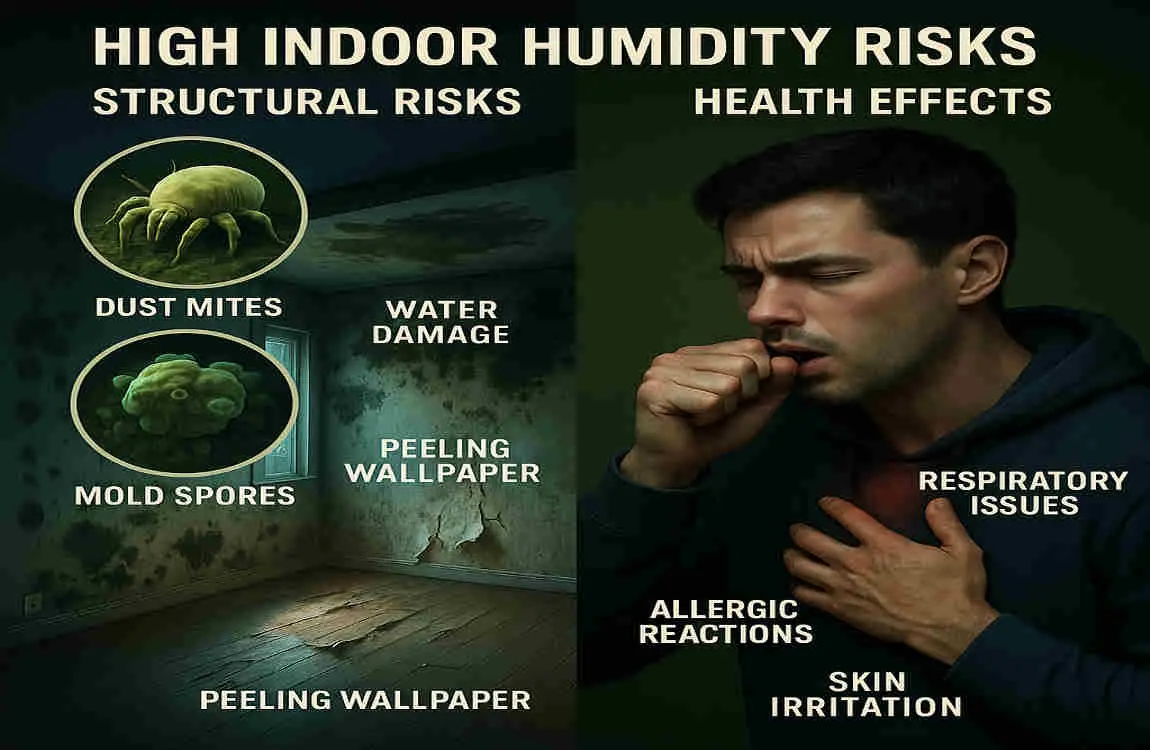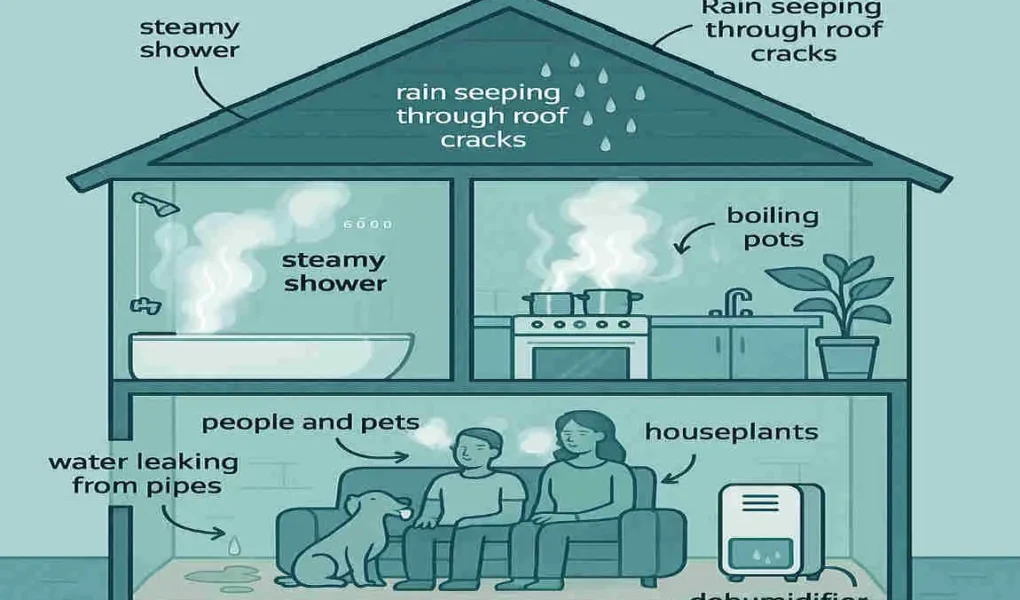Have you ever walked into your home on a pleasant day, only to feel like you’ve stepped into a tropical rainforest? You’re not alone. Many homeowners struggle with indoor humidity levels that seem stubbornly higher than the comfortable outdoor air. This puzzling phenomenon can turn your sanctuary into an uncomfortable, sticky environment that affects everything from your health to your home’s structural integrity.
Understanding why it is more humid in my house than outside isn’t just about comfort—it’s about protecting your investment and your family’s wellbeing. Indoor humidity impacts the air you breathe, the longevity of your furniture and building materials, and even your energy bills. When moisture levels climb too high, they create the perfect breeding ground for mold, dust mites, and other unwelcome guests.
Understanding Humidity and Indoor Air Quality
Before diving into solutions, let’s establish what we’re dealing with. Humidity refers to the amount of water vapor present in the air. When we talk about relative humidity, we’re measuring the percentage of moisture in the air compared to the maximum amount it could hold at that temperature.
Think of air as a sponge. Warm air acts like a bigger sponge, capable of holding more moisture than cold air. This is why summer often feels more humid—the warm air can carry more water vapor, making everything feel sticky and uncomfortable.
Indoor and outdoor humidity levels often differ dramatically, and here’s why that matters. While outdoor humidity fluctuates with weather patterns and natural air circulation, indoor humidity gets trapped. Your home acts like a sealed container, holding onto moisture from various sources without the benefit of natural wind patterns to carry it away.
The effects of high indoor humidity extend far beyond simple discomfort. When humidity levels climb above 60%, you might notice:
- Difficulty breathing or increased allergy symptoms
- Condensation forming on windows and walls
- Wood furniture and floors are beginning to warp or swell
- Paint and wallpaper are starting to peel or bubble
- Musty odors permeate fabrics and carpets
Monitoring your indoor humidity isn’t just recommended—it’s essential for maintaining a healthy home. The ideal indoor relative humidity ranges between 30% and 50%, with most experts recommending you stay closer to 40-45% for optimal comfort and health. This range prevents both the problems associated with excessive moisture and the discomfort of overly dry air.
Understanding these basics empowers you to recognize when something’s amiss if you’re constantly asking yourself, “Why is it more humid in my house than outside?” you’re already on the right track to solving the problem.
Common Reasons Why It Is More Humid in My House Than Outside
Sources of Indoor Moisture
Your home generates moisture constantly, often in ways you might not realize. Every breath you take, every shower you enjoy, and every meal you cook adds water vapor to your indoor air. Let’s explore these hidden moisture sources that contribute to higher indoor humidity.
Daily activities create more moisture than most people imagine. When you take a hot shower, you’re releasing pounds of water vapor into the air. Cooking releases moisture too—boiling pasta, simmering soups, or even using your dishwasher adds significant humidity. If you’ve ever noticed your kitchen windows fogging up while preparing dinner, you’ve witnessed this moisture production firsthand.
Drying clothes indoors presents another primary moisture source. A single load of laundry can release up to two liters of water into your home’s air as it dries. During winter months or rainy seasons when outdoor drying isn’t practical, this becomes a significant contributor to indoor humidity problems.
Your beloved houseplants and aquariums, while beautiful, continuously release moisture through transpiration and evaporation. A large aquarium can add several gallons of water to your indoor air each week. Similarly, that collection of tropical plants you’re nurturing? They’re working like tiny humidifiers, releasing moisture through their leaves constantly.
Hidden moisture sources often cause the most significant problems. Plumbing leaks, even small ones, create persistent humidity issues. That barely noticeable drip under your sink or the slow leak in your bathroom wall doesn’t just waste water—it pumps moisture directly into your home’s air and building materials.
Basements and crawl spaces frequently harbor moisture problems. These areas often have direct contact with soil, which naturally contains moisture. Without proper vapor barriers or ventilation, this ground moisture seeps into your home continuously. If your basement smells musty or feels damp, you’ve identified a major contributor to your indoor humidity issues.
Poor Ventilation and Air Circulation
Modern homes face a paradox: we’ve made them energy-efficient by sealing them tight, but this efficiency traps moisture inside. Without adequate ventilation, humid air has nowhere to go, creating that stuffy, uncomfortable atmosphere you’re experiencing.
Your home needs to breathe, just like you do. When ventilation is inadequate, moisture from all those daily activities we discussed gets trapped. It’s like putting a lid on a pot of boiling water—the steam has nowhere to escape, so it condenses on every available surface.
HVAC systems play a crucial role in managing indoor humidity. A properly functioning system doesn’t just heat or cool your air; it also removes excess moisture. However, if your system is outdated, improperly sized, or poorly maintained, it might actually contribute to humidity problems rather than solve them.
Those energy-efficient windows and doors you installed to save on heating and cooling costs? While they’re great for your energy bills, they can inadvertently trap moisture inside. Without the natural air exchange that occurs through drafty windows and doors, humidity levels can quickly climb beyond comfortable ranges.
Bathroom and kitchen exhaust fans serve as your first line of defense against moisture buildup. Yet, many homes have fans that are either too weak, improperly installed, or not used at all. Running these fans during and after moisture-producing activities is crucial, but they need actually to vent outside—not just into your attic or another indoor space.
Weather and Seasonal Factors
The relationship between outdoor weather and indoor humidity is complex and often surprising. During rainy seasons or in naturally humid climates, outdoor moisture finds countless ways to infiltrate your home. Even with windows and doors closed, humidity seeps through tiny gaps, gets tracked in on shoes and clothing, and enters through your home’s natural air exchange.
Seasonal changes dramatically impact indoor humidity levels. In summer, air conditioning systems work overtime to remove both heat and moisture. However, if your AC unit is oversized, it might cool your home too quickly without running long enough to dehumidify effectively. This leaves you with a calm but clammy indoor environment.
Winter brings its own humidity challenges. Heating systems can create unexpected moisture problems. While the heated air itself is dry, the temperature differences between indoor and outdoor air can cause condensation on windows and walls. Additionally, we tend to seal our homes tighter in winter, trapping moisture from cooking, bathing, and breathing with nowhere to escape.
Climate plays a massive role in your indoor humidity struggles. If you live in a coastal area, near large bodies of water, or in naturally humid regions, you’re fighting an uphill battle. The ambient outdoor humidity constantly tries to equalize with your indoor environment, making it challenging to maintain comfortable levels inside.
Diagnosing and Measuring Indoor Humidity Levels
Understanding your home’s humidity starts with accurate measurement. You can’t fix what you don’t measure, and guessing at humidity levels often leads to ineffective solutions or unnecessary expenses.
Hygrometers are your essential tool for monitoring indoor humidity. These devices, ranging from simple analog models to sophisticated digital versions, provide real-time humidity readings. Please place them in multiple rooms to get a complete picture of your home’s moisture patterns. You might discover that humidity levels vary dramatically between your basement and your upstairs bedrooms.
Modern technology offers even more sophisticated options. Smart home humidity sensors connect to your phone, providing alerts when levels climb too high. Some integrate with HVAC systems, automatically adjusting to maintain optimal humidity. These devices can track patterns over time, helping you identify when and where humidity problems occur.
The ideal indoor humidity range of 30-50% isn’t arbitrary—it represents the sweet spot for human comfort and home preservation. Below 30%, you’ll experience dry skin, irritated sinuses, and static electricity. Above 50%, you enter the danger zone for mold growth and structural damage.
Recognizing the signs of excessive humidity doesn’t always require instruments. Your home often provides clear signals:
Visual Signs, Physical Sensations, Other Indicators
Condensation on windows , Sticky, clammy feeling, Musty odors
Water stains on walls/ceilings. Difficulty breathing. Clothes are taking forever to dry
Peeling paint or wallpaper, increased allergy symptoms , Creaky, swollen doors
Visible mold growth , Sleep discomfort , Foggy mirrors that won’t clear
Comparing indoor and outdoor humidity requires measuring both simultaneously. On a day when outdoor humidity is comfortable (say, 45%), but your indoor reading shows 65%, you’ve confirmed that the problem originates inside your home. This comparison helps you determine whether you need to focus on reducing internal moisture sources or improving ventilation.
Health and Structural Risks of High Indoor Humidity

The impact of excessive indoor humidity extends far beyond simple discomfort. Your health and your home’s integrity are at stake when moisture levels remain elevated for extended periods.
Respiratory problems often worsen in high-humidity environments. The moist air provides ideal conditions for allergens like dust mites, which thrive when humidity exceeds 50%. These microscopic creatures trigger allergic reactions, asthma attacks, and other breathing difficulties. If you’ve noticed increased sneezing, coughing, or wheezing at home, humidity might be the hidden culprit.
Mold and mildew pose serious health threats. These fungi release spores that can cause everything from mild allergic reactions to severe respiratory infections. Some molds produce mycotoxins—toxic compounds that can lead to neurological problems and other serious health issues. Once mold takes hold in your home, it spreads rapidly through humid air, making early prevention crucial.
The structural damage from excess humidity accumulates slowly but surely. Wood absorbs moisture like a sponge, causing it to swell, warp, and eventually rot. Your beautiful hardwood floors might cup or buckle. Door frames swell until doors won’t close properly. Window sills deteriorate, compromising your home’s envelope.
Paint and finishes suffer too. High humidity causes paint to bubble and peel, destroying your walls’ appearance and exposing underlying materials to damage further. Metal fixtures and fasteners begin to rust, weakening structural connections throughout your home.
Perhaps most concerning, humid conditions attract unwanted guests. Termites, carpenter ants, and other wood-destroying insects seek out moist wood. Cockroaches and silverfish thrive in damp environments. By maintaining high indoor humidity, you’re essentially rolling out the welcome mat for these destructive pests.
Practical Solutions to Reduce Indoor Humidity
Improving Ventilation
Ventilation is your first and most cost-effective defense against indoor humidity. Start with the basics: those exhaust fans in your bathroom and kitchen exist for a reason. Use them religiously during and after moisture-producing activities. Run bathroom fans for at least 20 minutes after showers, and keep kitchen fans operating while cooking and for 15 minutes afterward.
Strategic window management can work wonders on days when outdoor humidity is lower than indoor levels. Open windows on opposite sides of your home to create cross-ventilation. This natural airflow carries moisture-laden air outside while bringing in drier air. Even a few hours of good airflow can significantly reduce indoor humidity.
Consider upgrading your HVAC system with humidity control features. Modern systems often include built-in humidistats that automatically monitor and adjust moisture levels. If a complete system upgrade isn’t feasible, adding a whole-house dehumidifier to your existing HVAC can provide similar benefits at a lower cost.
Don’t overlook simple solutions, such as ceiling fans. While they don’t remove moisture, they improve air circulation, preventing humid air from stagnating in corners and creating problem areas. Run ceiling fans year-round, adjusting the direction seasonally for optimal air movement.
Controlling Moisture Sources
Attacking humidity at its source proves more effective than constantly trying to remove it after the fact. Start by conducting a thorough leak inspection. Check under sinks, around toilets, near water heaters, and anywhere else water flows through your home. Even tiny leaks contribute significant moisture over time.
Rethink your indoor plant collection. While you don’t need to abandon your green thumb entirely, consider moving moisture-loving plants outdoors or to well-ventilated areas—group plants together in rooms with good airflow rather than scattering them throughout your home. Use saucers under pots to catch excess water, and avoid overwatering.
When it comes to laundry, explore alternatives to indoor drying. If outdoor drying isn’t possible, ensure your dryer vents directly outside and check the vent regularly for clogs. Alternatively, dry clothes in a well-ventilated room with a dehumidifier running, or invest in a ventless dryer that condenses moisture rather than releasing it into your home.
Cooking habits make a difference, too. Use lids on pots to contain steam, run exhaust fans while cooking, and consider using slow cookers or pressure cookers that release less moisture. When possible, grill outdoors during humid seasons to keep that moisture outside where it belongs.
Using Dehumidifiers and Other Technology
When ventilation and source control aren’t enough, technology steps in to save the day. Dehumidifiers come in various sizes and styles, each suited to different needs:
- Portable dehumidifiers work well for single rooms or problem areas
- Whole-house dehumidifiers integrate with HVAC systems for comprehensive control
- Desiccant dehumidifiers excel in cooler temperatures where traditional units struggle
Choosing the right dehumidifier requires calculating your space’s needs. For a 500-square-foot space with moderate humidity, a 30-pint unit usually suffices. Larger areas or severe humidity problems might require 50-pint or even 70-pint models. Look for Energy Star-certified units to minimize operating costs.
Intelligent humidity control has revolutionized moisture management. Wi-Fi-enabled dehumidifiers allow you to monitor and adjust settings remotely. Some models learn your patterns and adjust automatically, maintaining optimal humidity while minimizing energy use. These innovative features prove especially valuable for vacation homes or rental properties.
Don’t forget about moisture barriers in problem areas. Installing vapor barriers in basements and crawl spaces prevents ground moisture from entering your home. Combined with proper drainage and waterproofing, these barriers can eliminate primary sources of indoor humidity.
Maintenance Tips to Keep Indoor Humidity Balanced Year-Round
Consistency is key when managing indoor humidity. Regular maintenance prevents minor issues from becoming major problems and keeps your humidity control systems operating efficiently.
HVAC maintenance deserves top priority. Change filters monthly during peak seasons—dirty filters restrict airflow and reduce dehumidification. Schedule professional tune-ups twice yearly to ensure your system removes moisture effectively. Clean condensate drains regularly to prevent clogs that can cause water backup and increased humidity.
Seasonal vigilance pays dividends. As seasons change, so do your humidity challenges. In spring, check for winter damage that might allow moisture infiltration. Clear gutters and downspouts to direct rain away from your foundation. Summer requires monitoring AC performance and ensuring adequate ventilation during periods of high humidity.
Create a monthly humidity check routine:
- Test humidity levels in multiple rooms
- Inspect for signs of excess moisture (condensation, musty smells)
- Check and clean exhaust fan filters
- Examine weather stripping around doors and windows
- Look for new cracks or gaps in your home’s envelope
Lifestyle adjustments support your mechanical efforts. Take shorter, cooler showers. Run dishwashers and washing machines during cooler parts of the day when you can open windows. Keep bathroom and bedroom doors open when possible to promote air circulation.
Document your efforts and results. Keep a simple log of humidity readings, weather conditions, and any adjustments you make. Over time, you’ll identify patterns and develop an intuitive understanding of your home’s humidity behavior.




